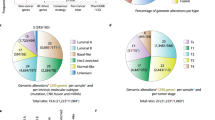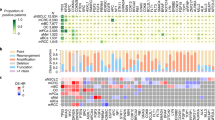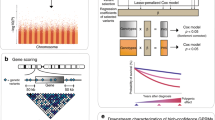Abstract
Life diversity can now be clearly explored with the next-generation DNA sequencing technology, allowing the discovery of genetic variants among individuals, patients and tumors. However, beyond causal mutations catalog completion, systems medicine is essential to link genotype to phenotypic cancer diversity towards personalized medicine. Despite advances with traditional single genes molecular research, including rare mutations in BRCA1/2 and CDH1 for primary prevention and trastuzumab for treating HER2-overexpressing breast and gastric tumors, overall, treatment failure and death rates are still alarmingly high. Revolution in sequencing reveals that, now both a huge number and widespread variability of driver mutations, including single-nucleotide polymorphisms, genomic rearrangements and copy-number changes involved in breast cancer development. All these genetic alterations result in a heterogeneous deregulation of signaling pathways, including EGFR, HER2, VEGF, Wnt/Notch, TGF and others.Cancer initiation, progression and metastases are driven by complex molecular networks rather than linear genotype–phenotype relationship. Therefore, clinical expectations by traditional molecular research strategies targeting single genes and single signaling pathways are likely minimal. This review discusses the necessity of molecular networks modeling to understand complex gene–gene, protein–protein and gene–environment interactions. Moreover, the potential of systems clinico-biological approaches to predict intracellular signaling pathways components networks and cancer heterogeneous cells within an individual tumor is described. A flowchart specific for three steps in cancer evolution separately tumorigenesis, early-stage and advanced-stage breast cancer is presented. Using reverse engineering starting with the integration of available established clinical, environmental, treatment and oncological outcomes (survival and death) data and then the still incomplete but progressively accumulating genotypic data into computational networks modeling may lead to bionetworks-based discovery of robust biomarkers and highly effective cancer drugs targets.
This is a preview of subscription content, access via your institution
Access options
Subscribe to this journal
Receive 6 print issues and online access
$259.00 per year
only $43.17 per issue
Buy this article
- Purchase on Springer Link
- Instant access to full article PDF
Prices may be subject to local taxes which are calculated during checkout


Similar content being viewed by others
References
Heppner GH . Tumor heterogeneity. Cancer Res 1984; 44: 2259–2265.
Hanahan D, Weinberg RA . The hallmarks of cancer. Cell 2000; 100: 57–70.
Wood LD, Parsons DW, Jones S . The genomic landscapes of human breast and colorectal cancers. Science 2007; 318: 1108–1113.
Jones S, Zhang X, Parsons DW . Core signaling pathways in human pancreatic cancers revealed by global genomic analyses. Science 2008; 321: 1801–1806.
Stratton MR, Campbell PJ, Futreal PA . The cancer genome. Nature 2009; 458: 719–724. Review.
Time for the epigenome. Nature 2010; 463: 587.
Li M, Chen WD, Papadopoulos N, Goodman SN, Bjerregaard NC, Laurberg S et al. Sensitive digital quantification of DNA methylation in clinical samples. Nat Biotechnol 2009; 27: 858–863.
Mardis ER, Ding L, Dooling DJ, Larson DE, McLellan MD, Chen K et al. Recurring mutations found by sequencing an acute myeloid leukemia genome. N Engl J Med 2009; 361: 1058–1066.
Ley TJ, Mardis ER, Ding L, Fulton B, McLellan MD, Chen K et al. DNA sequencing of a cytogenetically normal acute myeloid leukaemia genome. Nature 2008; 456: 66–72.
Pleasance ED, Stephens PJ, O’Meara S, McBride DJ, Meynert A, Jones D et al. A small-cell lung cancer genome with complex signatures of tobacco exposure. Nature 2009; 463: 184–190.
Pleasance ED, Cheetham RK, Stephens PJ, McBride DJ, Humphray SJ, Greenman CD et al. A comprehensive catalogue of somatic mutations from a human cancer genome. Nature 2010; 463: 191–196.
Ding L, Ellis MJ, Li S, Larson DE, Chen K, Wallis JW et al. Genome remodelling in a basal-like breast cancer metastasis and xenograft. Nature 2010; 464: 999–1005.
Stephens PJ, McBride DJ, Lin ML, Varela I, Pleasance ED, Simpson JT et al. Complex landscapes of somatic rearrangement in human breast cancer genomes. Nature 2009; 462: 1005–1010.
Hahn WC, Weinberg RA . Modelling the molecular circuitry of cancer. Nat Rev Cancer 2002; 2: 331–341.
Joyce JA, Pollard JW . Microenvironmental regulation of metastasis. Nat Rev Cancer 2009; 9: 239–252.
Roukos DH . Systems medicine: a real approach for future personalized oncology? Pharmacogenomics 2010; 11: 283–287.
Schadt EE . Molecular networks as sensors and drivers of common human diseases. Nature 2009; 461: 218–223.
Roukos DH . Novel clinico-genome network modeling for revolutionizing genotype-phenotype-based personalized cancer care. Expert Rev Mol Diagn 2010; 10: 33–48.
Rockman MV . Reverse engineering the genotype-phenotype map with natural genetic variation. Nature 2008; 456: 738–744.
Kamangar F, Dores GM, Anderson WF . Patterns of cancer incidence, mortality, and prevalence across five continents: defining priorities to reduce cancer disparities in different geographic regions of the world. J Clin Oncol 2006; 24: 2137–2150.
Jemal A, Siegel R, Ward E, Hao Y, Xu J, Thun MJ et al. Cancer statistics 2009. CA Cancer J Clin 2009; 59: 225–249.
Chabner BA, Roberts Jr TG . Timeline: chemotherapy and the war on cancer. Nat Rev Cancer 2005; 5: 65–72.
Early Breast Cancer Trialists’ Collaborative Group (EBCTCG). Effects of chemotherapy and hormonal therapy for early breast cancer on recurrence and 15-year survival: an overview of the randomized trials. Lancet 2005; 365: 1687–1717.
Songun I, Putter H, Kranenbarg EM, Sasako M, van de Velde CJ . Surgical treatment of gastric cancer: 15-year follow-up results of the randomised nationwide Dutch DLD2 trial. Lancet Oncol 2010; 11: 439–449.
Cunningham D, Allum WH, Stenning SP, Thompson JN, Van de Velde CJ, Nicolson M et al. Perioperative chemotherapy versus surgery alone for resectable gastroesophageal cancer. N Engl J Med 2006; 355: 11–20.
Macdonald JS, Smalley SR, Benedetti J, Hundahl SA, Estes NC, Stemmermann GN et al. Chemoradiotherapy after surgery compared with surgery alone for adenocarcinoma of the stomach or gastroesophageal junction. N Engl J Med 2001; 345: 725–730.
Sakuramoto S, Sasako M, Yamaguchi T, Kinoshita T, Fujii M, Nashimoto A et al. Adjuvant chemotherapy for gastric cancer with S-1, an oral fluoropyrimidine. N Engl J Med 2007; 357: 1810–1820.
Roukos DH . Genome-wide association studies and aggressive surgery toward individualized prevention, and improved local control and overall survival for gastric cancer. Ann Surg Oncol 2009; 16: 795–798.
Miki Y, Swensen J, Shattuck-Eidens D, Futreal PA, Harshman K, Tavtigian S et al. A strong candidate for the breast and ovarian cancer susceptibility gene BRCA1. Science 1994; 266: 66–71.
Wooster R, Bignell G, Lancaster J, Swift S, Seal S, Mangion J et al. Identification of the breast cancer susceptibility gene BRCA2. Nature 1995; 378: 789–792.
Guilford P, Hopkins J, Harraway J, McLeod M, McLeod N, Harawira P et al. E-cadherin germline mutations in familial gastric cancer. Nature 1998; 392: 402–405.
Narod SA, Foulkes WD . BRCA1 and BRCA2: 1994 and beyond. Nat Rev Cancer 2004; 4: 665–676.
Ziogas D, Roukos DH . CDH1 testing: can it predict the prophylactic or therapeutic nature of total gastrectomy in hereditary diffuse gastric cancer? Ann Surg Oncol 2009; 16: 2678–2681.
Roukos DH . Genome-wide association studies: how predictable is a person's cancer risk? Expert Rev Anticancer Ther 2009; 9: 389–392.
Gschwind A, Fischer OM, Ullrich A . The discovery of receptor tyrosine kinases: targets for cancer therapy. Nat Rev Cancer 2004; 4: 361–370.
Baselga J, Swain SM . Novel anticancer targets: revisiting ERBB2 and discovering ERBB3. Nat Rev Cancer 2009; 9: 463–475.
Slamon DJ, Leyland-Jones B, Shak S, Fuchs H, Paton V, Bajamonde A et al. Use of chemotherapy plus a monoclonal antibody against HER2 for metastatic breast cancer that overexpresses HER2. N Engl J Med 2001; 344: 783–792.
Van Cutsem E, Kang Y, Chung H, Shen A, Sawaki F, Lordick J et al. Efficacy results from the ToGA trial: a phase III study of trastuzumab added to standard chemotherapy (CT) in first-line human epidermal growth factor receptor 2 (HER2)-positive advanced gastric cancer (GC). J Clin Oncol 2009; 27 (Suppl): 18s (abstr LBA4509).
Roukos DH . Targeting gastric cancer with trastuzumab: new clinical practice and innovative developments to overcome resistance. Ann Surg Oncol 2010; 17: 14–17.
Petrelli NJ, Winer EP, Brahmer J, Dubey S, Smith S, Thomas C et al. Clinical cancer advances 2009: major research advances in cancer treatment, prevention, and screening—a report from the American society of clinical oncology. J Clin Oncol 2009; 27: 6052–6069.
Burstein HJ . The distinctive nature of HER2-positive breast cancers. N Engl J Med 2005; 353: 1652–1654.
Hortobagyi GN . Trastuzumab in the treatment of breast cancer. N Engl J Med 2005; 353: 1734–1736.
Smith I, Procter M, Gelber RD, Guillaume S, Feyereislova A, Dowsett M et al. 2-year follow-up of trastuzumab after adjuvant chemotherapy in HER2-positive breast cancer: a randomised controlled trial. Lancet 2007; 369: 29–36.
Perez EA, Romond EH, Suman VJ, Jeong NE, Davidson CE, Geyer S et al. Updated results of the combined analysis of NCCTG N9831 and NSABP B-31 adjuvant chemotherapy with/without trastuzumab in patients with HER2-positive breast cancer. J Clin Oncol 2007; 25: 512.
Romond EH, Perez EA, Bryant J, Suman VJ, Geyer Jr CE, Davidson NE et al. Trastuzumab plus adjuvant chemotherapy for operable HER2-positive breast cancer. N Engl J Med 2005; 353: 1673–1684.
Piccart-Gebhart MJ, Procter M, Leyland-Jones B, Goldhirsch A, Untch M, Smith I et al. Trastuzumab after adjuvant chemotherapy in HER2-positive breast cancer. N Engl J Med 2005; 353: 1659–1672.
Slamon D, Eiermann W, Robert NJ, Pienkowski T, Martin M, Pawlicki M et al. BCIRG 006: II interim analysis phase III randomized trial comparing doxorubicin and cyclophosphamide followed by docetaxel with doxorubicin and cyclophosphamide followed by docetaxel and trastuzumab with docetaxel, carboplatin and trastuzumab in Her2neu positive early breast cancer patients. The 2006 San Antonio Breast Cancer Symposium; December 14–17, 2006; San Antonio, Texas.
Slamon D, Eiermann W, Robert NJ, Pienkowski T, Martin M, Pawlicki M et al. Phase III randomized trial comparing doxorubicin and cyclophosphamide followed by docetaxel with doxorubicin and cyclophosphamide followed by docetaxel and trastuzumab with docetaxel, carboplatin and trastuzumab in HER2 positive early breast cancer patients: BCIRG 006 study. The 2005 San Antonio Breast Cancer Symposium; December 8–11, 2005; San Antonio, Texas.
Joensuu H, Kellokumpu-Lehtinen PL, Bono P, Alanko T, Kataja V, Asola R et al. Adjuvant docetaxel or vinorelbine with or without trastuzumab for breast cancer. N Engl J Med 2006; 354: 809–820.
Dahabreh IJ, Linardou H, Siannis F, Fountzilas G, Murray S . Trastuzumab in the adjuvant treatment of early-stage breast cancer: a systematic review and meta-analysis of randomized controlled trials. Oncologist 2008; 13: 620–630.
Bergh J . Quo vadis with targeted drugs in the 21st century? J Clin Oncol 2009; 27: 2–5.
Roukos DH . Mea culpa with cancer-targeted therapy: new thinking and new agents design for novel, causal networks-based, personalized biomedicine. Expert Rev Mol Diagn 2009; 9: 217–221.
Gandara DR, Gumerlock PH . Epidermal growth factor receptor tyrosine kinase inhibitors plus chemotherapy: case closed or is the jury still out? J Clin Oncol 2005; 23: 5856–5858.
Stafford RS, Wagner TH, Lavori PW . New, but not improved? Incorporating comparative-effectiveness information into FDA labeling. N Engl J Med 2009; 361: 1230–1233.
Van Cutsem E, Köhne CH, Hitre E, Zaluski J, Chang Chien CR, Makhson A et al. Cetuximab and chemotherapy as initial treatment for metastatic colorectal cancer. N Engl J Med 2009; 360: 1408–1417.
Mitsudomi T, Morita S, Yatabe Y, Negoro S, Okamoto I, Tsurutani J et al. Gefitinib versus cisplatin plus docetaxel in patients with non—small-cell lung cancer harbouring mutations of the epidermal growth factor receptor (WJTOG3405): an open label, randomised phase 3 trial. Lancet Oncol 2010; 11: 121.
Bastiaens P . Systems biology: when it is time to die. Nature 2009; 459: 334–335.
Roukos DH, Tzakos A, Zografos G . Current concerns and challenges towards tailored anti-angiogenic therapy in cancer. Expert Rev Anticancer Ther 2009; 9: 1413–1416.
Ellis LM, Reardon DA . Cancer: the nuances of therapy. Nature 2009; 458: 290–292.
de Boer M, van Deurzen CH, van Dijck JA, Borm GF, van Diest PJ, Adang EM et al. Micrometastases or isolated tumor cells and the outcome of breast cancer. N Engl J Med 2009; 361: 653–663.
Roukos DH . Isolated tumor cells in breast cancer. N Engl J Med 2009; 361: 1994–1995.
Sotiriou C, Pusztai L . Gene-expression signatures in breast cancer. N Engl J Med 2009; 360: 790–800.
Paik S, Shak S, Tang G, Kim C, Baker J, Cronin M et al. A multigene assay to predict recurrence of tamoxifen-treated, node-negative breast cancer. N Engl J Med 2004; 351: 2817–2826.
van de Vijver MJ, He YD, van’t Veer LJ, Dai H, Hart AA, Voskuil DW et al. A gene-expression signature as a predictor of survival in breast cancer. N Engl J Med 2002; 347: 1999–2009.
Roukos DH . Twenty-one-gene assay: challenges and promises in translating personal genomics and whole-genome scans into personalized treatment of breast cancer. J Clin Oncol 2009; 27: 1337–1338.
O’Shaughnessy JA . Molecular signatures predict outcomes of breast cancer. N Engl J Med 2006; 355: 615–617.
Huang CC, Bredel M . Use of gene signatures to improve risk estimation in cancer. JAMA 2008; 299: 1605–1606.
Eichhorn PJ, Baselga J . HER2 signatures in breast cancer: ready to go to print? J Clin Oncol 2010; 28: 1809–1810.
Partnership to Improve Patient Care. Individualized Patients Personalized Care 2009. PIPC: Washington, DC http://www.improvepatientcare.org/individualized-patients-personalized-care (Accessed April 17, 2009).
Shendure J, Ji H . Next-generation DNA sequencing. Nat Biotechnol 2008; 26: 1135–1145.
Roukos DH . Bionetworks-based personalized medicine vs comparative-effectiveness research or harmonization of both in cancer management? Expert Rev Mol Diagn 2010; 10: 247–250.
Valid concerns. Nature 2010; 463: 401–402.
Goldstein DB . 2020 visions personalized medicine. Nature 2010; 463: 27.
Eichhorn PJ, Gili M, Scaltriti M, Serra V, Guzman M, Nijkamp W et al. Phosphatidylinositol 3-kinase hyperactivation results in lapatinib resistance that is reversed by the mTOR/phosphatidylinositol 3-kinase inhibitor NVP-BEZ235. Cancer Res 2008; 68: 9221–9230.
Beroukhim R, Mermel CH, Porter D, Wei G, Raychaudhuri S, Donovan J et al. The landscape of somatic copy-number alteration across human cancers. Nature 2010; 463: 899–905.
He Y, Wu J, Dressman DC, Iacobuzio-Donahue C, Markowitz SD, Velculescu VE et al. Heteroplasmic mitochondrial DNA mutations in normal and tumour cells. Nature 2010; 464: 610–614.
Barnett GC, Shah M, Redman K, Easton DF, Ponder BA, Pharoah PD . Risk factors for the incidence of breast cancer: do they affect survival from the disease? J Clin Oncol 2008; 26: 3310–3316.
Pharoah PD, Antoniou AC, Easton DF, Ponder BA . Polygenes, risk prediction, and targeted prevention of breast cancer. N Engl J Med 2008; 358: 2796–2803.
Wacholder S, Hartge P, Prentice R, Garcia-Closas M, Feigelson HS, Diver WR et al. Performance of common genetic variants in breast-cancer risk models. N Engl J Med 2010; 362: 986–993.
Miller DG . On the nature of susceptibility to cancer. The presidential address. Cancer 1980; 46: 1307–1318.
Schinzel AC, Hahn WC . Oncogenic transformation and experimental models of human cancer. Front Biosci 2008; 13: 71–84.
Beerenwinkel N, Antal T, Dingli D, Traulsen A, Kinzler KW, Velculescu VE et al. Genetic progression and the waiting time to cancer. PLoS Comput Biol 2007; 3: e225.
Goldhirsch A, Ingle JN, Gelber RD, Coates AS, Thürlimann B, Senn HJ, Panel members. Thresholds for therapies: highlights of the St Gallen international expert consensus on the primary therapy of early breast cancer 2009. Ann Oncol 2009; 20: 1319–1329.
Roukos DH, Ziogas D . From tumor size and HER2 status to systems oncology for very early breast cancer treatment. Expert Rev Anticancer Ther 2010; 10: 123–128.
Peterson RT . Drug discovery: propping up a destructive regime. Nature 2009; 461: 599–600.
Arora PS, Ansari AZ . Chemical biology: a notch above other inhibitors. Nature 2009; 462: 171–173.
The human genome at ten. Nature 2010; 464: 649–650.
Collins F . Has the revolution arrived? Nature 2010; 464: 674–675.
Venter JC . Multiple personal genomes await. Nature 2010; 464: 676–677.
Weinberg R . Point: hypotheses first. Nature 2010; 464: 678.
Golub T . Counterpoint: data first. Nature 2010; 464: 679.
Human genome at ten: the sequence explosion. Nature 2010; 464: 670–671.
Abbott A . Human genome at ten: the human race. Nature 2010; 464: 668–669.
Check Hayden E . Human genome at ten: life is complicated. Nature 2010; 464: 664–667.
Author information
Authors and Affiliations
Corresponding author
Ethics declarations
Competing interests
The author declares no conflict of interest.
PowerPoint slides
Rights and permissions
About this article
Cite this article
Roukos, D. Trastuzumab and beyond: sequencing cancer genomes and predicting molecular networks. Pharmacogenomics J 11, 81–92 (2011). https://doi.org/10.1038/tpj.2010.81
Received:
Revised:
Accepted:
Published:
Issue Date:
DOI: https://doi.org/10.1038/tpj.2010.81
Keywords
This article is cited by
-
The Role of Epithelial Mesenchymal Transition (EMT) in Pathogenesis of Cardiotoxicity: Diagnostic & Prognostic Approach
Molecular Biotechnology (2023)
-
Boolean ErbB network reconstructions and perturbation simulations reveal individual drug response in different breast cancer cell lines
BMC Systems Biology (2014)
-
Rapid learning for precision oncology
Nature Reviews Clinical Oncology (2014)
-
From single protein to colorectal cancer genome landscape and network biology-based biomarkers
Surgical Endoscopy (2013)
-
Dynamic imaging in medicine and network biology
Surgical Endoscopy (2013)



